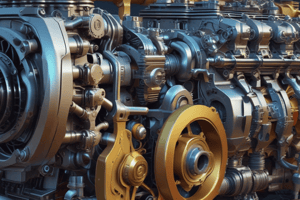Podcast
Questions and Answers
The 2-Stroke Cycle is a more complex version of the 4-Stroke Cycle.
The 2-Stroke Cycle is a more complex version of the 4-Stroke Cycle.
False (B)
The displacement of an engine is measured in kilometers per liter.
The displacement of an engine is measured in kilometers per liter.
False (B)
The crankshaft converts piston motion into rotary motion.
The crankshaft converts piston motion into rotary motion.
True (A)
Horsepower is a measure of engine torque.
Horsepower is a measure of engine torque.
The camshaft operates the valves, allowing air and fuel into cylinders.
The camshaft operates the valves, allowing air and fuel into cylinders.
Fuel efficiency is measured in miles per hour.
Fuel efficiency is measured in miles per hour.
The electric engine uses fuel combustion to generate power.
The electric engine uses fuel combustion to generate power.
The 4-Stroke Cycle consists of intake, compression, power, and exhaust stages.
The 4-Stroke Cycle consists of intake, compression, power, and exhaust stages.
Flashcards are hidden until you start studying
Study Notes
Engine
Types of Engines
- Internal Combustion Engine (ICE): Most common type, uses fuel combustion to generate power
- Electric Engine: Uses electric motors, powered by batteries or generators
- Hybrid Engine: Combination of ICE and electric motor
Engine Components
- Cylinders: Chambers where fuel is ignited to produce power
- Pistons: Move up and down in cylinders, driven by explosive force
- Crankshaft: Converts piston motion into rotary motion
- Camshaft: Operates valves, allowing air and fuel into cylinders
- Valves: Control air and fuel flow into cylinders
Engine Cycles
- 4-Stroke Cycle:
- Intake: Air and fuel mixture enters cylinder
- Compression: Mixture is compressed
- Power: Mixture is ignited, piston moves down
- Exhaust: Exhaust gases exit cylinder
- 2-Stroke Cycle: Simplified version, used in some small engines
Engine Performance
- Horsepower (HP): Measure of engine power
- Torque: Rotational force, measured in lb-ft or Nm
- Displacement: Engine size, measured in liters (L) or cubic centimeters (cc)
Engine Efficiency
- Fuel Efficiency: Measured in miles per gallon (mpg) or kilometers per liter (km/L)
- Emissions: Engine emissions, regulated by environmental standards
Engine Types
- Internal Combustion Engine (ICE): uses fuel combustion to generate power
- Electric Engine: uses electric motors, powered by batteries or generators
- Hybrid Engine: combines ICE and electric motor
Engine Components
Cylinders and Pistons
- Cylinders: chambers where fuel is ignited to produce power
- Pistons: move up and down in cylinders, driven by explosive force
Crankshaft and Camshaft
- Crankshaft: converts piston motion into rotary motion
- Camshaft: operates valves, allowing air and fuel into cylinders
Valves
- Control air and fuel flow into cylinders
Engine Cycles
4-Stroke Cycle
- Intake: air and fuel mixture enters cylinder
- Compression: mixture is compressed
- Power: mixture is ignited, piston moves down
- Exhaust: exhaust gases exit cylinder
2-Stroke Cycle
- Simplified version, used in some small engines
Engine Performance
- Horsepower (HP): measures engine power
- Torque: rotational force, measured in lb-ft or Nm
- Displacement: engine size, measured in liters (L) or cubic centimeters (cc)
Engine Efficiency
- Fuel Efficiency: measured in miles per gallon (mpg) or kilometers per liter (km/L)
- Emissions: regulated by environmental standards
Studying That Suits You
Use AI to generate personalized quizzes and flashcards to suit your learning preferences.




